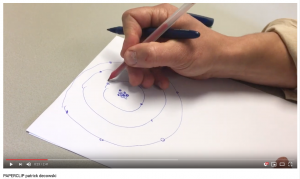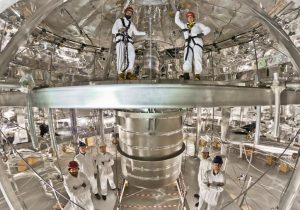Researchers Nikhef and UvA measure slowest radioactive decay ever
In the underground Gran Sasso laboratory in Italy, researchers have measured the slowest radioactive decay ever. The result is a spin-off from the XENON experiment’s search for dark matter, which uses several tons of liquid xenon. Nikhef and the UvA-Institute for High Energy Physics play a prominent role in the research. The work is published as a cover story in Nature on april 25th.
The decay time for the effect that the XENON-researchers published in Nature today is a world record: 18 billion trillion years. This is more than a trillion times longer than the current age of the universe.
‘At human time-scales, one would simply call this stable, but there really is a measurable decay’, says researcher Prof. Patrick Decowski (Nikhef/UvA). ‘The fact that we find a reliable value indicates the precision with which we can measure this type of effect.’
The measurements were carried out using a rare form of the element xenon: the isotope Xe-124. During the measurements, the experiment contained 3.2 tonnes of cold liquid xenon, which naturally contains some Xe-124. Researchers of the University of Münster played a leading role in the measurements.
In half a year’s worth of measurements, 126 decays were observed from this large amount of xenon. This was sufficient to accurately estimate the half-life of the decay: the amount of time in which the number of radioactive nuclei is halved.
In Xe-124, a process called double electron capture occurs. This is a rare form of radioactive decay in which two protons in the atom’s nucleus simultaneously capture an electron from the atom’s inner shell. In this process, the protons in the nucleus change into neutrons, resulting is an entirely new chemical element: tellurium. Two neutrinos are also produced.
Moreover, the process causes changes in the electron cloud surrounding the nucleus. When electrons from higher orbits fill the holes in the inner shell, radiation with a very specific energy is produced. This can be measured with the XENON detectors, and can be distinguished especially since this process produces a small amount of energy whereas the background radiation has a higher energy.

Apart from setting a world record, the measurements also have a scientific importance, says Decowski. ‘The nuclear model for large nuclei such as xenon is a rather ad hoc description. With further measurements, we can improve this model.’
A better understanding of xenon is especially valuable for the XENON experiment itself. The aim of the experiment is to find double flashes of light that occur when a dark matter particle collides with a xenon nucleus. The resulting acceleration causes a flash of light, after which the electrons that are torn from the atom cause a second flash.
This double flash of light is the signature that indicates the sought-for dark matter. XENON is filled with light detectors to be able to see this effect.
Dark matter is one of the enigmas in modern physics. The universe, especially in galaxies, appears to contain much more mass than we can see in the form of stars. It is still unknown what this dark matter consists of. In theory it could consist of unknown particles that are not yet incorporated in the standard model of particle physics.
So far, XENON has not found any dark matter. Currently, the experiment is being upgraded to contain more than 8 tonnes of xenon. Nikhef and the UvA are involved in this upgrade, which should make the experiment ten times more sensitive.
Researcher Prof. Auke-Pieter Colijn (Nikhef/UvA) is the technical coordinator of those upgrades. ‘This result indicates that we can measure very rare events. With the upcoming XENONnT-detector, this situation will only improve’, he says.
Observation of two-neutrino double electron capture in 124Xe with XENON1T, E. Aprile et al., Nature, 25 April 2019.
Onderzoekers hebben in Italië in het ondergrondse Gran Sasso-laboratorium het traagste radioactieve verval ooit gemeten. Het resultaat is een spin-off van de speurtocht met het XENON-experiment naar donkere materie, waarbij een paar ton vloeibaar xenon wordt gebruikt. Onderzoekers van Nikhef en UvA spelen in dat onderzoek een prominente rol. Het artikel is op donderdag 25 april als omslagartikel gepubliceerd in Nature.

De halfwaardetijd voor het effect dat de XENON-onderzoekers vandaag in Nature publiceren is een wereldrecord: 18 miljard biljoen jaar. Dat is meer dan een biljoen maal langer dan de leeftijd van het universum.
‘Voor menselijke maatstaven noem je zoiets gewoon stabiel, maar er is echt een meetbaar verval’, zegt onderzoeker prof. Patrick Decowski (Nikhef/UvA). ‘Dat we een betrouwbare waarde vinden, geeft vooral ook aan hoe precies we dit soort effecten kunnen meten.’
De metingen zijn gedaan aan een zeldzame vorm van het element xenon: het isotoop Xe-124. In het experiment zat tijdens de metingen 3,2 ton ijskoud vloeibaar xenon, waarvan van nature een deel Xe-124 is. Onderzoekers van de universiteit van Münster hadden het voortouw in de metingen.
In een halfjaar meettijd werd in dat volume xenon welgeteld 126 keer een verval gezien. Dat was voldoende voor een goede schatting van de halfwaardetijd van het verval: de tijd waarin het aantal radioactieve kernen is gehalveerd.
In Xe-124 komt zogeheten double electron capture voor, een zeldzaam radioactief verval waarbij twee protonen in de atoomkern tegelijk een elektron uit de binnenste schil van het atoom invangen. Daarbij worden de protonen in de kern omgezet in neutronen, zodat een heel nieuw chemisch element ontstaat: tellurium. Bij het proces komen ook twee neutrino’s vrij.
Het proces veroorzaakt bovendien veranderingen in de elektronenwolk rond de kern. Als elektronen uit een hoger gelegen baan de gaten in de binnenste schil opvullen, komt straling met een heel bepaalde energie vrij. Die blijkt met de detectoren van XENON te meten, vooral omdat het een proces met weinig energie is, terwijl veel hinderlijke achtergrondstraling juist meer energie heeft.
De metingen hebben behalve het meetrecord ook wel enig wetenschappelijk belang, zegt Decowski. ‘Het atoomkernmodel voor een groot atoom als xenon is nogal ad hoc beschreven. Met meer meetgegevens is dat model te verbeteren.’

Een beter begrip van xenon heeft daarmee waarde voor het XENON-experiment zelf. Daarin wordt gezocht naar dubbele lichtflitsen die ontstaan als een donkere-materiedeeltje een xenon-kern vol raakt. Door de versnelling ontstaat licht, en kort erna kan ook van losgeslagen elektronen nog licht worden waargenomen.
De tweevoudige lichtflits is de signatuur voor de gezochte donkere materie. XENON hangt vol met lichtdetectoren om zulke effecten te zien.
Donkere materie is een van de raadsels in de hedendaagse natuurkunde. In het heelal is met name in sterrenstelsels duidelijk meer massa aanwezig dan de massa van de sterren die we zien. Wat die donkere materie vormt is onbekend. In theorie kunnen het onbekende deeltjes zijn, die niet in het standaard deeltjesmodel voorkomen.
Tot nog toe heeft XENON nog geen donkere materie gevonden. Momenteel wordt het experiment uitgebreid naar ruim 8 ton xenon. Nikhef en UvA zijn nauw betrokken bij de uitbouw, die het experiment tienmaal gevoeliger zou moeten maken.
Onderzoeker Prof. Auke-Pieter Colijn (Nikhef/UvA) is technisch coördinator van die upgrades. ‘Dit resultaat geeft aan dat we zeer zeldzame gebeurtenissen kunnen waarnemen. Met onze XENONnT-detector kan dat alleen maar beter worden’, zegt hij.
Observation of two-neutrino double electron capture in 124Xe with XENON1T, E. Aprile et al., Nature, 25 april 2019.